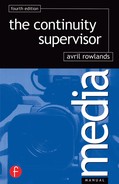Your first job, if you are involved in setting up a scripted production, is to take a dog-eared, much-scribbled-over, almost indecipherable draft script and turn it into a nicely typed, legible rehearsal script for everyone’s use. This might not be the final, definitive version, but everyone wants something to work from as soon as possible.
Every production is broken down into its smallest component – the script is divided into scenes and these, in turn, are broken down into shots. It is therefore vital to number and label everything clearly. Put the scene number and page number (i.e. Sc. II (13)) at the top and bottom right-hand side of each page. If there are a number of episodes you might find it useful to incorporate the episode number with the scene number (i.e. Episode 2, Scene 1 becomes 201; Episode 3, Scene 12 becomes 312, etc.).
Colour-code different episodes by having each script photocopied on different coloured paper.
Every change of location means a new scene. For example:
Scene 1 : Day. Interior. Kitchen
Scene 2 : Day. Interior. Lounge
Scene 3 : Day. Interior. Kitchen
A change of time at the same location often means a new scene. For example:
Scene 1 : Day. Interior. 1005. Kitchen
Scene 2 : Night. Interior. 2115. Kitchen
It is helpful to specify the exact time on the script – in terms of the story – in which the scene happens. For example:
Scene 1 : Day. 0925. Interior. Police Station
Scene 2 : Day. 0935. Interior. Police cell
Scene 3 : Day. 0950. Exterior. Park
This makes it easier to work out continuity of costumes and props and is also useful for setting the time of any clocks or watches in shot.
It is terribly important always to start a new scene on a fresh page, even if the scene only contains one line, i.e.
Scene 34 : Day. Exterior. Hillside
JO WATCHES THE TRAIN AS IT SPEEDS THROUGH THE VALLEY
Some directors prefer the script typed out with the scenes running straight through, thereby having perhaps two, three or even four short scenes on the same page. While this is admirable in terms of tree conservation and it is also makes for a thinner script, it is a nightmare for continuity and for the editor, and it makes the job of inserting rewrites and fresh scenes very difficult if not impossible. It is to be avoided at all costs!
The script should be typed single-sided only.
| Ep. 5, Sc. 6 | Page 16 |
| SCENE 505: EXT. STREET | SCENE 506: DAY. INT. OFFICE |
| PAULINE WALKING | LAURA IS SITTING BEHIND HER DESK, WHICH IS LITTERED WITH PAPER AND PHOTOGRAPHS. EVEN THE CHAIR IS FULL OF PAPERS. THERE IS A KNOCK ON THE DOOR. |
| LAURA Come in! | |
| PAULINE ENTERS THE ROOM AND APPROACHES THE DESK | |
| PAULINE I’ve come about the advertisement. | |
| LAURA Just a minute. (SHE FINISHES WHAT SHE IS DOING BEFORE LOOKING UP) You’ve come about …? | |
| PAULINE The advertisement. You know, the one in the paper. | |
| LAURA Oh, of course! (SHE SHAKES HANDS) Do sit down. Just put that junk anywhere. I always work in an awful mess, don’t you? Now you’re …? |
Example of script layout – Style 1
Page 16
